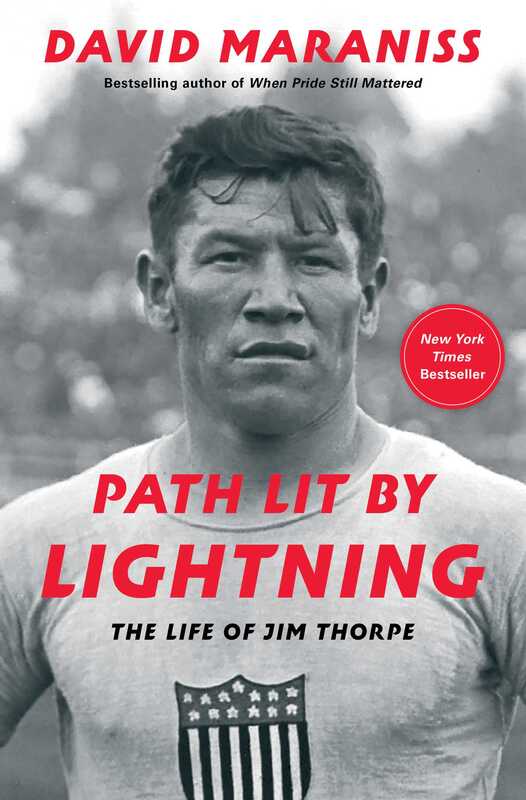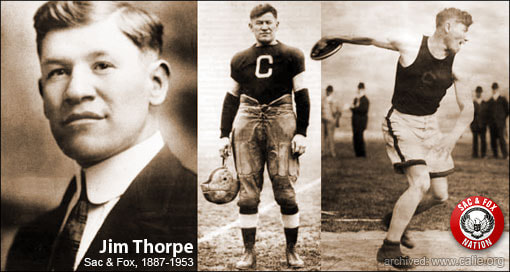|
When I was a kid, Jim Thorpe was still alive (he died in 1953, just short of 65.) Sportswriters and athletes and fans had seen him perform.
He had been dubbed “the most wonderful athlete in the world” or “the greatest athlete in the world” by the king of Sweden after dominating the 1912 Olympics in Stockholm. Thorpe was also known as the first great American football player who later played baseball for the New York Giants but could not hit a curveball. (Neither could Michael Jordan, decades later.) Thorpe was a cautionary tale – via snickering sports-page references to firewater and lack of discipline and other weaknesses. He was part of the broader picture of a country where white invaders felt they had holy permission to kill as many Native Americans as they could. The new Americans had various words and definitions for Jim Thorpe, back in the day -- "Chief" or "Redskin,” referring to his mixture of Sac and Fox, Potawatomi, Kickapoo, Menominee, as well as French and English. "By that definition, Jim Thorpe would tell people he was five-eighths Indian," writes David Maraniss In the stirring biography, "Path Lit by Lightning," a current best-seller published by Simon & Schuster. These days, some of us tend to use the word “Indigenous” rather than “Indians” or “Native Americans” for the descendants of people who lived for hundreds, thousands, of years on this continent, very often in harmony with nature and neighboring tribes. They were so far more complex than contemporary Americans can imagine. Great reporter that he is, Maraniss parses the life of a great athlete born on a reservation in Oklahoma, when the white invaders were taking what they wanted – often at the point of a gun. The title of the book refers to Thorpe’s name, translated from the Sac and Fox language, as American leadership tried to gouge the native words and ways out of the survivors of the killing fields. Whereas the Civil War general, Philip H. Sheridan was known for saying “The only good Indian is a dead Indian,” his philosophy had been moderated just a tad by Col. Richard Henry Pratt, the first superintendent of the Indian school at Carlisle, Pa. “In a sense, I agree with the sentiment,” Col. Pratt is quoted by Maraniss, “but only in this: that all the Indian there is in the race should be dead. Kill the Indian in him and save the man.” The most blatant example was in Carlisle, which recruited male athletes from all over the country, playing the top colleges (Ivy League!), and keeping the athletes in uniform as long as possible, in those days before the niceties of the N.C.A.A. Thorpe arrived in Carlisle, young and under-sized but rugged, hard to tame, motivated to play football better than anybody. Perhaps the most delightful surprise in the Maraniss book is the young teacher, the same age as Thorpe -- Marianne Moore, later a famous poet ensconced in the gentility of Fort Greene, Brooklyn. In letters to George Plimpton decades later, Moore described Thorpe’s strength and athletic gait and recalled him, as a “diligent” and polite student. She also told Plimpton that Thorpe had walked alongside her on campus and said, “Miss Moore, may I carry your parasol for you?” Another sweet little section is when Thorpe fell in love with a fellow student, Iva Miller, 20, from out west, who was raised among indigenous but was all Caucasian. Thorpe had been playing baseball for the professional New York Giants, recruited partially as an attraction for an off-season world tour in 1912 – Asia, Australia, Europe. The two were married before the train headed west from New York, and the 20-year-old bride filled her diary with the details of a girl in love with a man she called “Snooks” and also with the world out there. She took notes about seasickness and rickshas and shopping and parties, later riding donkeys or camels at the Pyramids and wandering around Paris to the Moulin Rouge and Napoleon’s tomb. The reader roots for her life to go on and on like this. But the “greatest” athlete was already blighted by the “revelation” that Thorpe had played minor-league baseball (for money) in his summers at Carlisle, and his Olympic medals were taken away for violating Olympic amateur standards. Needless to say, the poohbahs in the “amateur” world of sport and education knew nothing of his minor-league forays. Maraniss describes the role of noted Carlisle coach Pop Warner,”where everything was made to be subservient to athletes and football.” In other words, college football (and its coaches and presidents and boosters) hasn’t changed a bit in more than a century. The last third of the biography careers downhill -- divorce, two more marriages, children, tragedies, jumping from team to team, from baseball to football, working in construction during the Depression, erratic behavior, all so predictable, all so sad. Yet Maraniss points out that the indigenous people did not go away. He refers to the diversity and accomplishments of the indigenous today – doctors and lawyers and civil leaders, teachers and writers and performers. Off the top of my head, I toss out the current names of Deb Haaland, Secretary of the Interior, a Laguna Pueblo; Buffy Ste. Marie, Canadian-American from the Piapot Cree; and Louise Erdrich, writer, from the Turtle Mountain band of Chippewa. The invaders did not succeed in wiping out the Indian ways. And in this compelling biography, David Maraniss shows how, early in the 20th Century, Jim Thorpe took the hits.
Alan D. Levine
1/16/2023 07:38:28 pm
George--Were you in the same English class at JHS as I was when Marianne Moore visited and read her poetry? The one I remember is about her walking alongside a deer she had encountered in the woods.
GV
1/16/2023 07:47:11 pm
Alan, no, I'm sure I'd remember. I do remember when Mrs Gollobin invited Lotte Lenya to our performance
Altenir Silva
1/16/2023 07:39:19 pm
Dear George: The new Hollywood must be poked. Thorpe's story would make a wonderful movie, like your book, “Coal Miner’s Daughter.” Anyway, your comments about the Thorpe book made me want to read it, too.
GV
1/16/2023 07:50:37 pm
Dear Altenir: there was a Thorpe movie starring Burt
Altenir Silva
1/16/2023 08:34:53 pm
Dear George: I did not know this film. But I googled and found out the movie titled Jim Thorpe – All-American, directed by Michael Curtiz, the Casablanca guy.
George
1/17/2023 08:44:54 am
Altenir: I am not a movie buff -- then or now -- but I have seen Lancaster in two quirky movies -- "The Swimmer," about a suburban guy having a psychic breakdown as he walks from pool to pool in bathing suit....and "Atlantic City" where he plays an aging gangster (as I recall) who laments the downfall of the Atlantic -- something about it once having been a better ocean, (Probably more right than anybody realized at the time.) GV
Walter schwartz
1/16/2023 09:50:28 pm
Sadly, there are too many similarities in the lives of Jim Thorpe and Joe Louis, two of the greatest and most accomplished American athletes in the first half of 20th century, unique and iconic in their own ways, but victims of racial stereotyping, who ultimately struggled to make a living, suffering from depression, alcohol and failing health. I recommend Kate Buford’s “Native Son-Jim Thorpe” and Randy Roberts, “Joe Louis”.
GV
1/17/2023 08:50:42 am
Chief: spot on. I was thinking of Joe Louis while writing this piece, He disintegrated in front of our eyes. I remember going to Las Vegas (a/k/a Hell on Earth) to cover a later Ali fight, circa 1980, and seeing Joe Louis in a booth in the lobby of one of those hotels. He looked like a mechanical mock-up of the real Joe Louis, moving slowly from side to side, nodding to tourists. It took me minutes to realize that was the real, or what was left of, Joe Louis, making a buck., Long into middle age, Thorpe demonstrated his punting skills at halftime of games....GV
Ed Martin
1/16/2023 10:49:08 pm
When Alan and I were young, on opposite sides of the Lehigh Valley, there was a town called Mauch Chunk in the PA. “Coal regions” not far away. There were other names of towns, similar roots, Tamaqua, etc.
GV
1/17/2023 08:57:21 am
Ed, you refer to your college-soccer-colleague, Alan Rubin, I take it.
Ed
1/17/2023 12:46:56 pm
Apropros of date, an American who inspired us, and many others, Dr. Martin Luther King, another tragedy.
Alan D. Levine
1/16/2023 11:08:19 pm
I recently saw Jim Thorpe referred to as the greatest all-around athlete of the twentieth century. I'm not so sure. What about Babe Diedricksen?
GV
1/17/2023 09:01:27 am
Alan, fair question,Hard to compare. Until very recently, women';s sports got very little coverage, but Babe D certainly was known in her time. The female athletes we see today have so many more opportunities to train, compete, reach the public, plus make money. GV
Phyllis Rosenthal
1/17/2023 07:46:59 am
Another American tragedy.
GV
1/17/2023 09:10:22 am
Hey, Phyllis, nice to see your name. You are referring to Thorpe....or Babe Didrikson? Either way, athletes have it better today, male or female, until they don't. (Athletes who go broke, or suffer brain damage -- I knew a lot of them.)
Chris Vecsey
1/17/2023 01:47:14 pm
Dear Brother George,
GV
1/17/2023 08:15:23 pm
Chris: young Christopher has good taste in gifts.
Ed
1/17/2023 04:50:48 pm
I like this enough to send smiles, warmth,
bruce
1/17/2023 05:04:36 pm
george,
GEORGE VECSEY
1/17/2023 08:23:44 pm
Bruce, my bad, not thinking of Robbie Robertson, Yes, he has paid more homage to his mother's roots in Six Nations since he left the Band -- I was also surprised to read in his autobiography that he later found out he is part Jewish,
bruce
1/17/2023 08:31:45 pm
george,
EdCanuck Partime
1/17/2023 10:38:48 pm
Only in America, includes Mexico and US along with Canada. Just sayin’
Josh Rubin
1/19/2023 01:02:18 pm
I always chuckle now when I see Robertson's name. Close followers of The Band and their history tend to divide into "team Robbie" and "team Levon." We saw a show at the Levon Helm studio in Woodstock a few years back, and in the merch shop, tacked to the wall, are two of Levon's album covers (Dirt Farmer and Electric Dirt) and next to them someone scrawled in laundry marker on the wall "Where's your grammy, Robbie?" Of course, Levon, as we here know, was in a movie adaptation of a certain book.
Alan D. Levine
1/17/2023 05:25:39 pm
Sweet Smell of Success
bruce
1/19/2023 01:21:05 pm
alan,
bruce
1/17/2023 10:48:05 pm
edcanuck...i'm purty sure a rather large percentage of americans aren't thinking of canada or mexico when they come up with one of the more common sayings in american political public life.
Ed
1/18/2023 02:51:20 pm
Dear Maple Leaf, Bruce,
bruce
1/18/2023 04:30:57 pm
ed, caught me walking on the rail trail. i know. was replying in kind.
GEORGE VECSEY
1/19/2023 10:18:16 am
Bruce, you know how much I love the True North Strong and Free. 1/18/2023 12:08:54 pm
Jim Thorpe was my idle when I was a kid. As I grew older, my appreciation for him grew.
bruce
1/19/2023 10:34:02 am
george,
bruce
1/19/2023 01:27:59 pm
josh, Comments are closed.
|
Categories
All
|











